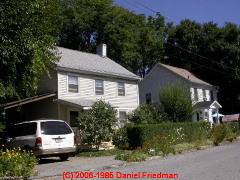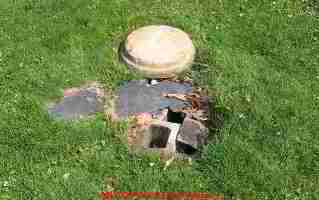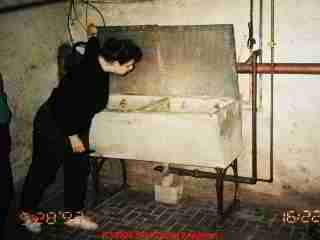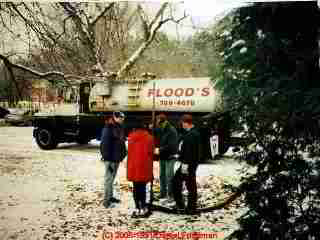 Guide to Inspecting Older buildings Connected to a Municipal Sewer System
Guide to Inspecting Older buildings Connected to a Municipal Sewer System
- POST a QUESTION or COMMENT about how to figure out if a home is connected to public sewer or private septic
Special inspection and investigation are needed for buildings which are older than the public sewer to which they are connected.
This article discusses what a property buyer or home inspector should do when examining a home or other older building which is reported connected to a public sewer.
In our photo above this mid 19th century home was built before the local sewer system was installed. In fact it has been connected to the village public sewer..
InspectAPedia tolerates no conflicts of interest. We have no relationship with advertisers, products, or services discussed at this website.
- Daniel Friedman, Publisher/Editor/Author - See WHO ARE WE?
Sewer Connection Inspection Guide for buildings Built Before Sewer system Installation
 Action guide when buying a building where a public sewer system is present but the building is older than the sewer system
Action guide when buying a building where a public sewer system is present but the building is older than the sewer system
[Click to enlarge any image]
But in older communities, especially if the age of a building is greater than the age of the community sewer system, even if a sewer is installed right in the street in front of a building, on occasion the building may never have been connected to the public sewer main. Or possibly only some of the building's plumbing fixtures and drains have been connected to the sewer while others remain connected to an old drywell, cesspool or septic tank.
Watch out: Failure to connect an older building to a sewer line can lead to some ugly surprises, including unanticipated expense to repair an old septic system, expense to connect the building to the new sewer line, and even serious life safety hazards if an old septic tank is at risk of collapse.
Our friend Steve Vermilye, an inspector and contractor in New Paltz, New York, discovered that an office building that everyone thought had been connected to the New Paltz sewer system for decades was in fact connected to an old cesspool in the back yard of the property.
That condition was discovered during new construction, happily before someone fell into the cesspool.
Find out if the building is really connected to the sewer system.
- If a sewer system is present in the street on which the home is located, is the home connected to the sewer or is it connected to a private septic system? Again this is a legitimate question to ask the seller and realtor to answer.
- But don’t bet on getting an accurate reply. People are sometimes mistaken and on occasion dishonest.
- Even if the older building is connected to the sewer system, if there is a chance (see clues below) that the home pre-dates the sewer system you should also check for the following:
Look for old fixtures or baths that are not connected to drain piping that leads to the sewer system.
Our photo shows an antique basement laundry sink. Often older homes connected a laundry or basement sink to a separate drywell.
Sometimes a bathroom in a distant location was not connected to the original septic tank, especially one added after initial construction and located at the far end of the building from other plumbing fixtures.

Look for evidence of drywells, cesspools, or even multiple septic tanks at older buildings. Often there were multiple of such systems installed, either to reduce the load on the main septic tank and drainfield or because it was easier to install a small separate cesspool or drywell for a distant bath than to try to connect it to an existing septic system.
Our photo shows an old septic tank home-made cover that is about to collapse - this was very dangerous and needed immediate steps to prevent someone from falling into the septic tank.
When such properties are later connected to a municipal sewer system, sometimes these separate an distant plumbing fixtures are forgotten. This seems to be very often the case with basement laundry sinks which were originally connected to a separate drywell.
See These Clues indicate that a building is or is not connected to a municipal sewer
These Clues indicate that a building is or is not connected to a municipal sewer system
If the home or building is newer than the sewer system
Certainly if the building is newer than the date of the sewer main that you’ve established as present in the neighborhood, it would be unusual for it not to have been connected to the sewer line.
If the age of the building is older than the sewer system
If a building pre-dates the installation of a community sewer line, then at one time it was connected to a private septic system – and it might still be.
In our photo , the stone foundation tells us that even if a sewer line is available for this building, the building almost certainly pre-dates the installation of the sewer.
The view of two kinds of modern plastic drain piping tell us that the main drain line has been replaced and that there is no house trap - at least none indoors (sometimes they're just outside the foundation wall - a stupid location since you have to dig them up to service the trap).
We conclude that the building where this photo was taken was probably connected to a private septic system at some time in its life. It might now be connected to a sewer, but further investigation is certainly needed to confirm that and to find out out if old abandoned septic components remain at the site.
- Locate the sewer main in relation to the house.
- Locate the main house drain where it exits the building.
- Does the main drain exit at the same side of the home as the location of the sewer main? If so that’s encouraging.
- Is there an old sewer line exiting a building wall that has now been capped off? If so, that’s an indication of an abandoned drain and perhaps an abandoned septic system.
- If you can confirm that the building is currently connected to a public sewer, be sure to review the additional steps needed
at Sewer Connection Inspection Guide for buildings Built Before Sewer system Installation - If you can confirm that the building is not connected to a public sewer, be sure to review the steps needed
at What Does It Mean If No Public Sewer Line is Present?
A septic system may be abandoned because a home was later connected to a sewer main or perhaps because a new septic system was installed elsewhere; but usually even if a new septic system is installed the house will continue to use its previously-existing main drain line.
So a cut off capped main waste line at a building wall suggests that an old system was abandoned. Septic tank abandonment involves some sanitation and safety concerns, so if you think there may be an abandoned septic system, see Septic Tank Abandonment Guide
Remember however that main waste line drain piping can also be routed in various directions outside of a home. So an old home with a septic tank in a back yard and a sewer main in the road in front of the house could have been connected to the sewer main by cutting into the waste line outside and running the line around the home from the back, along one side, out to the street in front.
Why would someone do this? After all, more excavating means more cost to connect to the sewer. In some cases an owner may find it is less disruptive to a home to dig outside than to reroute drain lines inside, especially if the home has a costly finished basement or lower level that would have to be torn up to reroute indoor drain piping.
What Does It Mean If No Public Sewer Line is Present?
If there is no sewer system present the home cannot be attached to one and a local septic system is or should be present.
But don’t bet on knowing the location and condition of such a system – some additional legwork is needed as important life-safety, functional, and expense concerns could be present.
See SEPTIC SYSTEM, HOME BUYERS GUIDE which discusses the inspections and tests that should be performed, introduces the need for septic system maintenance, and describes how to find septic tanks, distribution boxes, and drainfields.
...
Continue reading at GUIDE for BUILDINGS CONNECTED to PRIVATE SEPTIC or select a topic from the closely-related articles below, or see the complete ARTICLE INDEX.
Or see these
Recommended Articles
- FIND the SEPTIC TANK, HOW TO
- SEPTIC or SEWER CONNECTION?
- WHAT TO ASK ABOUT SEWERS or SEPTICS
- CLUES INDICATING A SEWER LINE is PRESENT
- CLUES INDICATING CONNECTED to SEWER
- GUIDE for BUILDINGS CONNECTED to PUBLIC SEWER
- GUIDE for BUILDINGS PRE-DATING SEWER INSTALLATION
- GUIDE for BUILDINGS CONNECTED to PRIVATE SEPTIC
- WHAT TO DO IF NO ONE KNOWS - if the connection is to sewer or septic
- SEPTIC VIDEOS show how to walk the site for possible septic tank & drainfield locations
- SEWER / SEPTIC PIPE CAMERAS to trace the sewer line to itns destination
Suggested citation for this web page
GUIDE for BUILDINGS PRE-DATING SEWER INSTALLATION at InspectApedia.com - online encyclopedia of building & environmental inspection, testing, diagnosis, repair, & problem prevention advice.
Or see this
INDEX to RELATED ARTICLES: ARTICLE INDEX to SEPTIC SYSTEMS
Or use the SEARCH BOX found below to Ask a Question or Search InspectApedia
Ask a Question or Search InspectApedia
Try the search box just below, or if you prefer, post a question or comment in the Comments box below and we will respond promptly.
Search the InspectApedia website
Note: appearance of your Comment below may be delayed: if your comment contains an image, photograph, web link, or text that looks to the software as if it might be a web link, your posting will appear after it has been approved by a moderator. Apologies for the delay.
Only one image can be added per comment but you can post as many comments, and therefore images, as you like.
You will not receive a notification when a response to your question has been posted.
Please bookmark this page to make it easy for you to check back for our response.
IF above you see "Comment Form is loading comments..." then COMMENT BOX - countable.ca / bawkbox.com IS NOT WORKING.
In any case you are welcome to send an email directly to us at InspectApedia.com at editor@inspectApedia.com
We'll reply to you directly. Please help us help you by noting, in your email, the URL of the InspectApedia page where you wanted to comment.
Citations & References
In addition to any citations in the article above, a full list is available on request.
- SEPTIC TANK/SOIL-ABSORPTION SYSTEMS: HOW TO OPERATE & MAINTAIN [PDF] - , Equipment Tips, U.S. Department of Agriculture, 8271 1302, 7100 Engineering, 2300 Recreation, September 1982, web search 08/28/2010, original source: http://www.fs.fed.us/t-d/pubs/pdfimage/82711302.pdf.
- Builder's Guide to Wells and Septic Systems, Woodson, R. Dodge: $ 24.95; MCGRAW HILL B; TP; Quoting from Amazon's description: For the homebuilder, one mistake in estimating or installing wells and septic systems can cost thousands of dollars. This comprehensive guide filled with case studies can prevent that. Master plumber R. Dodge Woodson packs this reader-friendly guide with guidance and information, including details on new techniques and materials that can economize and expedite jobs and advice on how to avoid mistakes in both estimating and construction. Chapters cover virtually every aspect of wells and septic systems, including on-site evaluations; site limitations; bidding; soil studies, septic designs, and code-related issues; drilled and dug wells, gravel and pipe, chamber-type, and gravity septic systems; pump stations; common problems with well installation; and remedies for poor septic situations. Woodson also discusses ways to increase profits by avoiding cost overruns.
- In addition to citations & references found in this article, see the research citations given at the end of the related articles found at our suggested
CONTINUE READING or RECOMMENDED ARTICLES.
- Carson, Dunlop & Associates Ltd., 120 Carlton Street Suite 407, Toronto ON M5A 4K2. Tel: (416) 964-9415 1-800-268-7070 Email: info@carsondunlop.com. Alan Carson is a past president of ASHI, the American Society of Home Inspectors.
Thanks to Alan Carson and Bob Dunlop, for permission for InspectAPedia to use text excerpts from The HOME REFERENCE BOOK - the Encyclopedia of Homes and to use illustrations from The ILLUSTRATED HOME .
Carson Dunlop Associates provides extensive home inspection education and report writing material. In gratitude we provide links to tsome Carson Dunlop Associates products and services.



